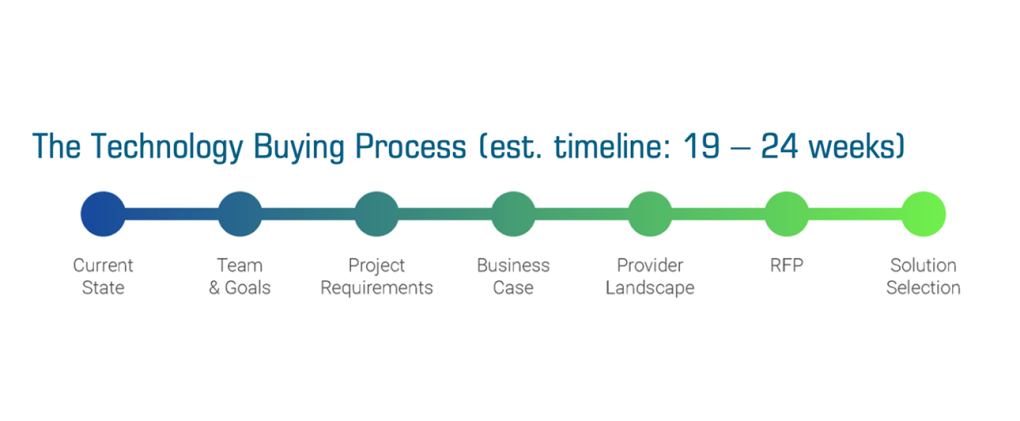An Ardent Partners Report Investigating, evaluating, and selecting the best-fit AP Automation software for your organization
The accounts payable profession continues to gain momentum and impact business operations and results in an increasingly strategic way. AP automation technology continues to play a major role in changing the way that AP teams are viewed within the enterprise. The Buyers' Guide to AP Automation is a process-focused report designed to help make the technology buying decision easier.
Introduction
Completing a successful transformation project within the accounts payable (“AP”) function can be both a straightforward and rewarding process.
Like any impactful project, its success depends on a high level of planning, commitment, and support from various stakeholders within the enterprise and strong, decisive leadership by the AP team. Given the overall efficiency, intelligence, and financial benefits that a successful AP automation project can deliver, the effort is well worth it.
One of the most important decisions in an AP transformation is selecting the underlying solution that will enable and support the overall project.
Accounts payable automation tools have an enabling effect for AP/finance/treasury teams: with them, teams can run tighter, leaner, and more efficient operations that can help to keep pace with the digitization happening across the rest of the enterprise. By removing manual and paper-based tasks, eliminating data entry, compressing approval times, enabling touchless processing, streamlining payments, and improving cash management and analytic capabilities, AP automation solutions have the potential to dramatically transform an AP operation.

This “Buyers' Guide” lays out a best practice approach that can be used to identify, evaluate, and ultimately select the best-fit solution based upon the organization’s unique budget and requirements. It also walks the reader through the seven key steps used to buy enterprise software solutions. The process has been designed for use by AP departments both large and small, and across all verticals and regions.
More detailed questions regarding AP automation and solution selection may be forwarded to research@ardentpartners.com.
Phase 1:
Assess the Current State of AP Operations
KEY STAKEHOLDERS: AP leadership, AP staff, and finance.
KEY ACTIVITIES: Describe the processes and organization in place today, highlighting the major pain points and key issues that affect the organization and AP stakeholders.
MAIN OBJECTIVES: (1) Establish a baseline of operations that can be used as inputs for both the definition of requirements and the formal business case (see Phase 4, page 9). (2) Determine the organizational ‘readiness’ for an AP transformation.
SMART TIP: Where data, information, and overall visibility are incomplete, do not get bogged down pursuing it. Instead, highlight the gaps as another major reason why transformation is needed.
SUGGESTED TIMELINE: 1 – 2 weeks.
The goal of this phase is to quickly assess the "current state" of AP operations and available resources including the people, processes, and technology currently in place. Understanding the current process for receiving, processing, and paying invoices is critical if the organization is going to make improvements.
Whether the plan is to automate some part or all of the entire process, it is important to understand how things currently work. Defining the current process will allow the organization to uncover specific pain points, which in turn will help to refine automation requirements.
The review should cover the following areas:
- Organization: Capture the structure, skills, and capabilities of the AP organization, as well as the overall alignment it has with functional partners in procurement and treasury and also, AP’s linkage to the strategic direction of the enterprise.
- Process: Define and model the key tasks, activities, and approaches taken to execute daily operations, including the receipt, processing, and payment of invoices (see the Ardent Partners’ ePayables Framework™ below).
- Technology: Describe the level of automation and how well technology is leveraged to enhance processes within the AP department.
- Knowledge Management: Detail the accessibility and visibility of data/information, including the ability to translate it into actionable intelligence for use within AP and across the enterprise.
- Performance: Establish key performance metrics before automation so that improvements can be measured.
To facilitate this current state assessment, use Ardent Partners’ ePayables Framework™ which was developed to help AP departments evaluate their main processes by dividing invoice and payment management into smaller, more manageable segments. In doing so, AP departments will be better able to understand what is needed to execute each phase and establish core project requirements.
The Framework organizes the AP process into three major phases:
1. RECEIVE – how the enterprise receives invoices.
2. PROCESS – how the enterprise validates and approves invoices.
3. PAY – how the enterprise schedules and executes payments.
Once the current state assessment is completed, the AP leadership can then complete the AP Transformation Readiness Checklist to determine whether or not the organization is well-positioned to undertake this project. If the organization is ready, proceed to the next step; if it is not, the AP leadership team must work to prepare the organization and the overall enterprise for the project.
Phase 2:
Build the Project Team and Establish Project Goals
KEY STAKEHOLDERS: AP leadership, finance, treasury, procurement, IT, line-of-business, and suppliers.
KEY ACTIVITIES: Identify and assemble a project team composed of the main AP process owners and representatives from the other key AP stakeholder groups. Define the hard and soft goals of the AP transformation project.
MAIN OBJECTIVES: (1) Build a strong project team drawn from across the enterprise that can help define, support, and execute the AP transformation project. (2) Define a compelling, yet realistic, set of goals for the overall project.
SMART TIP: The right team can make or break this project, so engage and sell the strongest potential advocates of an AP transformation on joining the team and/or actively supporting it.
SUGGESTED TIMELINE: 2 – 3 weeks
PROJECT TEAM: AP’s ability to make the business case for change and execute a successful transformation will benefit from the participation and support of other groups within the enterprise. Therefore, before making any technology investment decisions, relevant process owners and representative stakeholders across the AP spectrum should be assembled in a project team that can drive the development of a future state blueprint.
While a larger set of project stakeholders will bring a wider set of interests, priorities, and requirements to the discussion, the earlier these different inputs are identified the sooner they can be rationalized and prioritized into a comprehensive plan. Wider involvement of stakeholders is also a classic approach to establish project buy-in and promote user adoption.
Input should be gathered and incorporated from the following key stakeholder groups:
-
Finance/Treasury which manages an enterprise’s cash may have specific payment-related requirements and positive ideas on how AP automation can improve cash management.
-
Procurement which manages the initial part of the Procure-to-Pay process may be able to explain how an AP automation solution can improve overall supply/supplier management.
-
IT which understands the current IT infrastructure can help to define any integration requirements and constraints.
-
Line of Business whose end-user adoption rates will have an enormous impact on the overall success of the program. If a high number of system users come from the business, the line of business should have a representative voice in the solution selection and design processes.
-
Suppliers whose level of supplier enablement (or adoption) can be the “Achilles’ heel” of any AP transformation project. Understanding the inclination and preferences of suppliers regarding different solutions will help the project team understand the level of effort that will be required to enable suppliers onto the new AP platform.
PROJECT GOALS: In order to establish a solid foundation for the project, it is important to develop a long-term strategy and plan (see Phase 4, page 9). The organization must also have a clear sense of its long-term goals and objectives and the initiative’s potential impact on the enterprise. These goals are the solutions to the current problems, the plans for the future, and the main results to be achieved by the transformation; they will also drive the return on investment calculations. Goals and objectives should include hard and soft benefits.
Most projects include some, if not all, of the following goals:
- Reduce processing costs and times
- Reduce exception rates and other invoice processing issues
- Develop a more effective vendor payment strategy to help better manage and control cash and optimize working capital
- Minimize late payments and late payment penalties
- Use data to become a more intelligent operation
- Share AP data/information with functional partners to improve operations and performance
- Improve customer service and supplier relations
- Gain better visibility into process, line item detail and supplier performance
- Improve the ability to close the accounting period “books” in an accurate and timely manner
Phase 3:
Gather and Rationalize Key Project Requirements
KEY STAKEHOLDERS: Project team and extended stakeholders.
KEY ACTIVITIES: Work with the project team and extended stakeholders to define the overall project scope. Define what are absolute project requirements versus “nice-to-haves.” Prioritize requirements and gain consensus.
MAIN OBJECTIVES: Develop the project blueprint as well as a comprehensive set of solution requirements for the RFP. Capture what is needed by all AP staff and associated stakeholders.
SMART TIP: The number of competing views (and who holds them) may require the need for an executive sponsor who can help rationalize different groups’ requirements and help keep the development of the AP blueprint moving forward.
SUGGESTED TIMELINE: 2 – 3 weeks
The goal of this phase is to capture the critical functional and technical requirements for an AP automation solution that will be communicated via the comprehensive RFP (See Phase 4, next page) sent to solution providers. Utilize Ardent’s ePayables Framework (See Phase 1, page 4) to define the desired future state of activities across the full AP operation and work with IT to define technical needs.
A formal requirements document that includes the desired functional specifications, technical considerations, and all other relevant project needs (i.e., training, end-user support, project timing, high-level budget) should be developed with input from the full project team and select extended stakeholders. The document should prioritize requirements and highlight the interrelationship between specific solution capabilities and their impact on project goals. Stakeholder input can be invaluable in improving overall project performance and driving stakeholder acceptance and adoption. Make sure to use this process to engage constituents and manage expectations.
Phase 4:
Build the Business Case
KEY STAKEHOLDERS: Project team, finance leaders, stakeholders, and executives.
KEY ACTIVITIES: Work with the project team and extended stakeholders to build a single document that clearly lays out all of the key elements to the proposed AP automation project and a crisp argument for investment in it.
MAIN OBJECTIVES: Develop the formal business document that makes a logical and compelling argument for an investment in AP automation and transformation.
SMART TIP: The best business cases communicate information clearly and convincingly and have broad-based support. Before building the case, understand who the decision-makers are and what their main considerations are likely to be so that they may be directly addressed.
SUGGESTED TIMELINE: 4 weeks
A business case is a business document that is used to present a logical argument for initiating and investing in a specific project or technology. The purpose of any business case is to provide the critical information that key decision-makers need to make an informed decision as to whether or not a project is a worthwhile use of time, money, and resources and will deliver enough benefits to the enterprise that it should be pursued.
The goal of this document is to provide a compelling justification for an investment in an AP automation solution by explaining (at a high level) why the current problems demand a change and describing (at a high level) the desired solution and its likely impact. The business case can also be used to communicate the project to others and establish a method for measuring success.
Before starting the business case, it is essential to know which stakeholders should be involved in the decision-making process and why their input is important and valued. Key stakeholders should also be involved because they represent other functions or groups that will be impacted by the project. If the team is unsure who to involve, consider conducting an internal survey to identify key project constituents. Since projects with broad-based support are more likely to be approved, gaining strong allies can be the difference between a “go” or “no go” decision on the project.
The structure and format of the business case should match the standards set within your enterprise, but most business cases include the following sections.
Phase 5:
Analyze the Solution Provider Landscape
KEY STAKEHOLDERS: Project team, AP staff, and select end-users.
KEY ACTIVITIES: Use the key project requirements previously defined (see Phase 3, page 8) to investigate the marketplace and identify a list of potential providers that can support the project.
MAIN OBJECTIVES: Identify the list of providers (including contact information) that are likely qualified to receive and participate in the RFP.
SMART TIP: The success of the RFP is directly linked to engaging the right providers. So, while teams should always do independent research to find providers, they should consider tapping into third-party expertise, including published analyst reports that evaluate the AP automation landscape.
SUGGESTED TIMELINE: 2 weeks
A critical part of any AP automation project is finding the solution provider that best meets the organization’s key requirements (see Phase 3, page 8) and project budget. The solution provider marketplace is crowded and composed of many different types of solutions ranging from “scan and capture” providers to “eInvoicing” and complete “invoice-to-pay” solutions.
Understanding the different types of solutions that are available and the general capabilities delivered by each type of solution will help the team to identify the right types of providers to consider. Once it is clear which providers can support the scope of the project, the team should investigate individual solution providers. Since this phase may uncover new information that changes the current requirements, make sure to document and discuss any changes to the original scope or requirements. Download your copy of the 2021 ePayables Technology Advisor report.
Phase 6:
Develop and Launch the RFP
KEY STAKEHOLDERS: Project team, key stakeholders, IT and finance.
KEY ACTIVITIES: Merge the key project requirements (see Phase 3), critical information from the business case (see Phase 4), and any relevant learnings from researching the solution provider landscape (see Phase 5) into a market facing RFP document. Develop a sourcing project plan and timeline that sets a target date for all key milestones including contract execution. Send the RFP out to the solution providers identified in Phase 5 and communicate the timeline.
MAIN ACTIVITIES: Create and launch an RFP for the AP automation initiative that shares key information related to the enterprise and project, including key requirements and project timeline.
SMART TIP: The best RFPs leave little to the imagination of the bidders, so make sure to share the project background and overall goals, as well as what the project and RFP are trying to accomplish. Be very clear with what the key requirements and evaluation criteria are and make sure that the bidders understand the timeline for the RFP process, including RFP submission date, demonstration timeline, and the planned timing of the overall AP transformation project.
SUGGESTED TIMELINE: 4 weeks
The RFP for AP Automation developed in this phase must provide key project details and ask for important information to ensure that the right solution is ultimately selected.
The RFP should add structure to the entire solution selection process.
While the requirements and evaluation criteria for each enterprise may differ at the question or line-level, the general structure and format of an RFP should be fairly standard.
Since every RFP for AP Automation should be based on the unique requirements and situation of the enterprise launching it, the recommended RFP structure below should serve as a starting point for the reader
Phase 7:
Solution Selection, Contract Award and Negotiation
KEY STAKEHOLDERS: Project team, key stakeholders, IT, finance, and contract team.
KEY ACTIVITIES: The team reviews and evaluates all RFP responses, selects a short-list of finalists, conducts demonstrations, calls references, and awards and executes the final contract.
MAIN OBJECTIVES: Select the best-fit solution and execute a contract.
SMART TIP #1: Utilizing an online eSourcing tool can allow for better side-by-side bid comparisons, more comprehensive team discussions, and faster overall evaluations.
SMART TIP #2: Take control of the product demonstration process. When coordinating the product demonstrations, make sure to provide (at least one week prior) each provider with a script and/or punch list of features, activities, scenarios, and reports that must be displayed during the session.
SMART TIP #3: Evaluations and contract awards should be based upon what is in the existing solutions today and not on the expectation of any future product innovations. Solution product roadmaps are too unpredictable to make important decisions based upon them.
SMART TIP #4: Software salespeople are categorically “optimistic” about what their solutions can accomplish. If the project team has doubts about whether or not specific functionality is currently available, list the desired capabilities vendor “guarantees” in the final contract. Doing so commits the solution provider’s leadership to ensure that what is contractually defined gets delivered.
SUGGESTED TIMELINE: 4 weeks to award. 2 additional weeks to execute the contract.
After the RFP is launched (see Phase 6), the project team should communicate the project timeline and reconfirm all roles and responsibilities to all stakeholders, including those expected to evaluate the RFP responses, the end-users and IT staff who may participate in the product demonstrations, as well as the support staff that will drive and/or support the negotiation. External communication will also be important as some providers may have questions about the RFP.
While the RFP is with the solution providers, the team should meet to review and reconfirm:
- The evaluation criteria which can, and should, include price and non-price factors.
- The overall plan for down selection (or “short-listing”) of a smaller group of providers.
- The product demonstration schedule.
- Target dates for contract award and execution.
Once the bids are received, the team should work collaboratively to evaluate and rank the solution providers. From this process, a short list of providers should be identified and product demos should be scheduled (try to schedule them as close together as possible).
To ensure that the extended team gets a complete view of the solution offering, the project lead should send each provider a demo script and/or punch list of features, activities, scenarios, reports, and anything else that must be displayed during the session.
Conduct a total cost of ownership analysis, which includes all direct costs (i.e., subscription and transaction fees, etc.) and all indirect costs (i.e. systems integration costs, training and support fees, etc.). While the TCO is important, remember that the opportunity cost of selecting the wrong solution typically outweighs the total project investment. As such, make sure to incorporate non-price attributes in the evaluation criteria.
The contract negotiation and execution process should follow the enterprise’s best practices, led by the appropriate staff. Once executed, the team is set to do the exciting work of driving an AP transformation!
Conclusion
For more than a decade, Ardent Partners research has consistently shown that transforming an AP department is a worthwhile undertaking that can deliver significant bottom-line value while also elevating AP’s place within the organization. But successful AP transformation projects do not simply happen; they require a clear blueprint, the investment of time, money, and resources, as well as solid execution. The most direct and effective path to AP excellence begins with a plan that looks holistically across the entire process and incorporates and prioritizes the requirements of all AP stakeholders.
One of the most important decisions in an AP transformation project is selecting the underlying solution that will enable and support the overall transformation. By following a rigorous solution selection process as detailed in this Buyers' Guide, AP teams will be more likely to choose the best-fit solution, drive higher adoption, and ultimately, achieve their primary goals and objectives. Once transformed, an AP department’s ability to impact business processes, relationships, and results should expand demonstrably. But an AP transformation should have no defined end point; the work to improve AP should continue with a focus on how best to support the overall business and positively impact its operations and results.
Successful AP transformation projects do not simply happen; they require a clear blueprint, the investment of time, money and resources, as well as solid execution.


